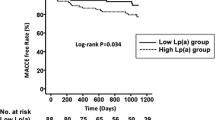Abstract
Lipoprotein (a) [Lp(a)] is a serum protein that has been reported to be predictive of complications from coronary and cerebrovascular atherosclerotic disease. This study was designed to compare plasma levels of Lp(a) in 100 white male patients with and without peripheral vascular disease (PVD) and to determine the role of Lp(a) as a risk factor for PVD independent of known risk factors such as cigarette smoking (CIG), diabetes mellitus (DM), and coronary artery disease (CAD). Patients with PVD (mean age =67.6 years, n=50) had a statistically significant (p=0.04) elevation of Lp(a) (29.8±3.9 mg/dl) as compared to patients without PVD (20.0±2.9 mg/dl (mean age =68.3 years, n=50). Further analysis revealed that patients with PVD had a significantly higher incidence of CIG (86% vs. 68%,p=0.03), DM (34% vs. 14%,p=0.02), and CAD (52% vs. 30%,p=0.02) than those without PVD. However, there was no statistically significant difference in Lp(a) levels in patients with CIG or CAD compared to those without. Patients with DM had significantly (p=0.04) lower levels of Lp(a) (17.8±3.5 mg/dl) than those without DM (27.1±3.0 mg/dl). Stepwise regression analysis of these various risk factors for PVD revealed that Lp(a) was the strongest significant individual predictor for the presence of PVD (R 2=0.07) as compared to DM (R 2=0.05) and CIG (R 2=0.04). We conclude that there is a significant correlation of Lp(a) levels and the incidence of PVD, which is independent of other major risk factors for PVD.
Similar content being viewed by others
References
Berg K. A new serum type system in man — the Lp system. Acta Pathol Microbiol Scand 1963;59:369–382.
Scanu AM. Lipoprotein (a): A potential-bridge between the fields of atherosclerosis and thrombosis. Arch Pathol Lab Med 1988;112:1045–1047.
Albers JJ, Cabana VG, Warnick GR, et al. Lp(a) lipoprotein: Relationship to sinking pre-β1-lipoprotein, hyperlipoproteinemia and apo-lipoprotein B. Metabolism 1975;24:1047–1054.
Dahlen GH. Lipoprotein (a) in relation to atherosclerotic diseases. In Naito HK, Widhalm K, eds. Recent Aspects of Diagnosis and Treatment of Lipoprotein Disorders: Impact on Prevention of Atherosclerotic Diseases. New York: Alan R. Liss, 1988, pp 27–36.
Utermann G, Menzel HJ, Kraft HG, et al. Lp(a) glycoprotein phenotypes: Inheritance and relation to Lp(a)-lipoprotein concentrations in plasma. J Clin Invest 1987;80:458–465.
Carlson LA, Hamsten A, Asplund A. Pronounced lowering of serum levels of lipoprotein Lp(a) in hyperlipidemic subjects treated with nicotinic acid. J Intern Med 1989;226:271–276.
Thompson PD, Cullinane EM, Sady SP, et al. Contrasting effects of testosterone and stanozolol on serum lipoprotein levels. JAMA 1989;261:1165–1168.
Maede S, Abe A, Seishima M, et al. Transient changes of serum lipoprotein(a) as an acute phase protein. Atherosclerosis 1989;78:145–150.
Dahlen G, Ericson C. A new lipoprotein pattern in patients with angina pectoris. Scand J Clin Lab Invest 1971;118(Suppl):54.
Armstrong VW, Cremer P, Eberle E, et al. The association between serum Lp(a) concentrations and angiographically assessed coronary atherosclerosis. Atherosclerosis 1986;62:249–257.
Dahlen GH, Guyton JR, Attar M, et al. Association of levels of lipoprotein Lp(a), plasma lipids, and other lipoproteins with coronary artery disease documented by angiography. Circulation 1986;74:758–765.
Kostner GM, Avogaro P, Cassolato G, et al. Lipoprotein Lp(a) and the risk for myocardial infarction. Atherosclerosis 1981;38:51–61.
Koltringer P, Jurgens B. A dominant role of lipoprotein(a) in the investigation and evaluation of parameters indicating the development of cervical atherosclerosis. Atherosclerosis 1985;58:187–198.
Murai A, Miyahara T, Fujimoto N, et al. Lp(a) lipoprotein as a risk factor for coronary heart disease and cerebral infarction. Atherosclerosis 1986;59:199–204.
Guyton JR, Dahlen GH, Patsch W, et al. Relationship of plasma Lp(a) levels to race and to apolipoprotein B. Arteriosclerosis 1985;5:265–272.
Dahlen G, Frick MH, Berg K, et al. Further studies of Lp(a) lipoprotein/pre-β1-lipoprotein in patients with coronary heart disease. Clin Genet 1975;8:183–189.
Dahlen G, Garsten P, Erikson H, et al. Insulin response to an oral glucose load in relation to Lp(a)/pre-β1-lipoprotein levels in non-diabetic patients with peripheral vascular disease and in controls. Acta Chir Scand 1979;145:447–454.
Rhoads GG, Dahlen G, Berg K, et al. Lp(a) lipoprotein as a risk factor for myocardial infarction. JAMA 1986;256:2540–2544.
Fuchs JCA. Atherogenesis and the medical management of atherosclerosis. In Rutherford RB, ed. Vascular Surgery, 3rd ed. Philadelphia: WB Saunders, 1989, pp 194–206.
Molgaard J, Klausen C, Lassvik C, et al. Significant association between low-molecular-weight apolipoprotein (a) isoforms and intermittent claudication. Arteriosclerosis Thromb 1992;12:895–901.
Mertz DP, Burvenich K. Unterschiedliche werte von lipoprotein Lp(a) bei erwachsenen diabetikern in abhangigkeit von der therapieform. Klin Wochenschr 1985;63:648–650.
Bruckert E, Davidoff P, Grimaldi A, et al. Increased serum levels of lipoprotein(a) in diabetes mellitus and their reduction with glycemic control. JAMA 1990;263:35–36.
Joven J, Vilella E. Serum levels of lipoprotein(a) in patients with well-controlled non-insulin-dependent diabetes mellitus. JAMA 1991;265:1113–1114.
Rath M, Niendorf A, Reblin T, et al. Detection and quantification of lipoprotein(a) in the arterial wall of 107 coronary bypass patients. Arteriosclerosis 1989;9:579–592.
Walton KW, Hitchens J, Magnani HN, et al. A study of methods of identification and estimation of Lp(a) lipoprotein and of its significance in health, hyperlipidemia and atherosclerosis. Atherosclerosis 1974;20:323–346.
Cushing GL, Gaubatz JW, Nava ML, et al. Quantitation and localization of apolipoproteins [a] and B in coronary artery bypass grafts resected at reoperation. Arteriosclerosis 1989;9:593–603.
Houlson R, Friedl W. Biochemistry and clinical significance of lipoprotein(a). Ann Clin Biochem 1988;25:499–503.
Utermann G. The mysteries of lipoprotein(a). Science 1989;246:904–910.
Karadi I, Kostner GM, Gries A, et al. Lipoprotein (a) and plasminogen are immunochemically related. Biochem Biophys Acta 1988;960:91–97.
Edelberg JM, Gonzalez-Gronow M, Pizzo SV. Lipoprotein(a) inhibition of plasminogen activation by tissue-type plasminogen activator. Thromb Res 1990;57:155–162.
Hajjar KA, Gavish D, Breslow JL, et al. Lipoprotein(a) modulation of endothelial cell surface fibrinolysis and its potential role in atherosclerosis. Nature 1989;339:303–305.
Miles LA, Fless GM, Levin EG, et al. A potential basis for the thrombotic risks associated with lipoprotein(a). Nature 1989;339:301–303.
Author information
Authors and Affiliations
Additional information
Supported by grants NIH NRSA F32HL0824501A1 to M.D.W. and NIH R29HL40305, RO1HL47345, and VA Merit Grant to B.E.S.
About this article
Cite this article
Widmann, M.D., Sumpio, B.E. Lipoprotein (a): A risk factor for peripheral vascular disease. Annals of Vascular Surgery 7, 446–451 (1993). https://doi.org/10.1007/BF02002128
Issue Date:
DOI: https://doi.org/10.1007/BF02002128




